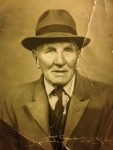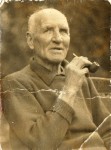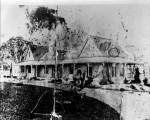HARRIS, Percy James
Percy James Harris was born 1st January 1875 at Thornton, Studley-park, Kew. He was the son of Alfred Harris. Two months later Alfred sold the contents of his house as he was leaving for England imminently. Whether he did or not remains uncertain as no shipping records have been found for his departure or return. We do know that Percy was in Melbourne and living in Albert Street, East Melbourne at the time of his marriage to Alice Donoloan on 22 April 1898. The 1898 Rate Books show an Alfred Harris as the occupier of a wooden house at 188 Albert Street, opposite Powlett Reserve. Percy and Alice had seven children and by the time of the birth of their second child in 1901 the couple had moved to The Hermitage, 11 Palmer Street, Jolimont, better known as the detached cottage Governor La Trobe built next to his own cottage. They called the child Marjorie Palmer. Percy was a keen cyclist and competed in races around Melbourne. In 1897 he competed in the LVW (Loaded Vehicle Weight) Cycling Championships held at the United Friendly Societies' track in the Second Class Handicap over two miles and the Novice Handicap over one mile.
He enlisted on 12 September 1914 nominating his wife, Alice, as his next of kin. She was then living in Richmond. He gave his occupation as clerk, and according to his family, enlisted as a result of his German boss being interned. He was appointed to the 14th Battalion and sent to Broadmeadows for training. He was discharged on 6 November 1914.
He enlisted again on 9 December 1914 stating that he had had military experience with the 14th Battalion but had been discharged owing to family reasons. This time he was appointed to the 7th Battalion, 3rd Reinforcements. He was nearly 40, was of average height, had a fresh complexion, blue eyes and light brown hair.
Percy embarked on the Runic on 19 February 1915 at which time Alice’s address was again The Hermitage. He had already been promoted to Corporal. He joined his battalion from reinforcements on 30 April 1915 thus missing the infamous Anzac landing. Five days later the troops were transferred to Cape Helles, then returned to Anzac, taking part in the Battle of Lone Pine. The battalion remained on the Gallipoli Peninsula until the evacuation in December 1915.
In October of that year Percy was admitted to hospital on Lemnos with haemorrhoids and then sent to England. He was back with his unit in Serapeum, Egypt, in March 1916, and was promptly promoted to Sergeant and then to Company Quarter Master Sergeant (CQMS). At the same time he was transferred to the 1st Australian Division Pioneer Battalion and embarked for France two weeks later arriving in early April.
A year later he was in hospital again, this time with scabies. While there he was diagnosed with valvular disease of the heart and sent to England where he was admitted to the 3rd Australian General Hospital in Brighton. He was sent home to Australia 4 May 1917 and was discharged on 11 August 1917.
A statement dated 17 August 1917 lists the pensions awarded to the family, now back living in Richmond. Percy himself was granted 35/6 per fortnight; Alice, his wife, was granted 17/9; James 10/-; Alice, his daughter 7/6; Violet 5/-; Sydney 5/-. The three younger children apparently needed nothing.
By the time of their daughter, Marjorie Palmer's marriage, Percy and Alice were living at 12 Mason Street, Hawthorn. Alice died in 1943 and afterwards, according to his family, Percy moved in with son, Sid, in Camberwell, taking frequent trips to his block of land in Frankston where he kept a market garden. His last address was 8 Florence Road, Surrey Hills. He died on 16 July 1947.
Helen Simons, email 5 June 2014
Can you help?
Can you correct or provide more information about this person?
Or are you able to help with this history project?
- Family stories and records including photos, documents and memorabilia?
- Stories or information in books, newspapers and on-line?
- Memorial plaques in churches and public places?
- War memorial, church, national and state archives?
If so, please Contact the East Melbourne Historical Society.



